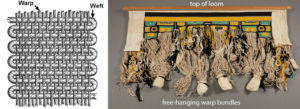Test your knowledge with a quiz
Chilkat Robe quiz
Key points
- The practice of Chilkat weaving originated among the Indigenous peoples and nations of southeast Alaska and the coasts of British Columbia and Washington State, including the Tlingit, Haida, and Tsimshian. The name refers to the Chilkat region of southeastern Alaska, home to the Chilkat Tlingit people.
- Chilkat weaving is carried out on a loom with a free-hanging warp, on which the vertical warp threads for the weaving are attached only at the top of the loom and not at the bottom. The weaving is done through the twining technique, interlacing weft (horizontal) threads of yarn with the warp threads by hand. Between the preparation of materials and the actual weaving, Chilkat weaving is a very time consuming process.

Left: Diagram by Alfred Barlow, adapted from The History and Principles of Weaving by Hand and by Power, 1878, Low, Marston, Searle & Rivington, London, CC BY-SA 3.0; right: Unfinished Chilkat Robe on loom, c.1920 (Northwest Coast), wool and wood start, 72 x 22 in (Portland Art Museum, Oregon)
- Robes are one of a number of items created using the Chilkat weaving technique. Robes have previously been referred to as blankets but the term robe more accurately reflects their purpose. Robes are worn and enlivened in ceremonial dance, activating the colors, designs, and voluminous fringe.
- For this robe, Dorica Jackson recreated a woven design featured in George Emmons’ 1907 book, The Basketry of the Tlingit and the Chilkat Blanket. Emmons was a collector and ethnographer who studied the Indigenous populations of Southeast Alaska in the late 19th and early 20th centuries. As part of his research, he received explanations of the Chilkat technique from Tlingit weavers.
- The symmetrical design of the robe fills the entire woven area. The design features a diving whale in the center, flanked by abstract figures on the two sides. The placement of specific colors within the design is consistent with the Chilkat tradition. Chilkat weaving is practiced by women, but the initial designs are created by men in the community.
Go deeper
Learn more about Tlingit weaver Clarissa Rizal’s Resilience Robe at the Portland Art Museum
Learn about Chilkat Robes, Tlingit Dance, and more at the Haines Sheldon Museum
Learn more about the Totem Heritage Center
Sources such as these by non-Indigenous authors have helped to document and revive the techniques of Chilkat weaving during a time when certain Indigenous cultural and artistic practices in the Northwest Coast region were restricted or no longer shared with new generations:
- George T. Emmons, The Basketry of the Tlingit and the Chilkat Blanket, American Museum of Natural History, 1907
- Cheryl Samuel, The Chilkat Dancing Blanket, The University of Oklahoma Press, 1990
More to think about
Compare two recently created Chilkat robes: Clarissa Rizal’s Resilience Robe, which blends motifs visible in today’s culture (like the doors of a museum) with those used in Chilkat weaving from the past, and Dorica Jackson’s reproduction of an older design she found in George Emmons’ 1907 book, The Basketry of the Tlingit and the Chilkat Blanket. How are both approaches to design meaningful for the Tlingit community today?
Dorica Jackson, like other Chilkat weavers, prepared all of the materials for this robe in addition to carrying out the time-consuming weaving process. She spun and dyed the wool, cut and strung the warp threads on the loom, and readied the weft threads for weaving. Working full time on these steps, a robe could take at least a year to create. What kinds of creations do you see in our contemporary culture which necessitate such time? What purpose do they serve and how do we value them?


